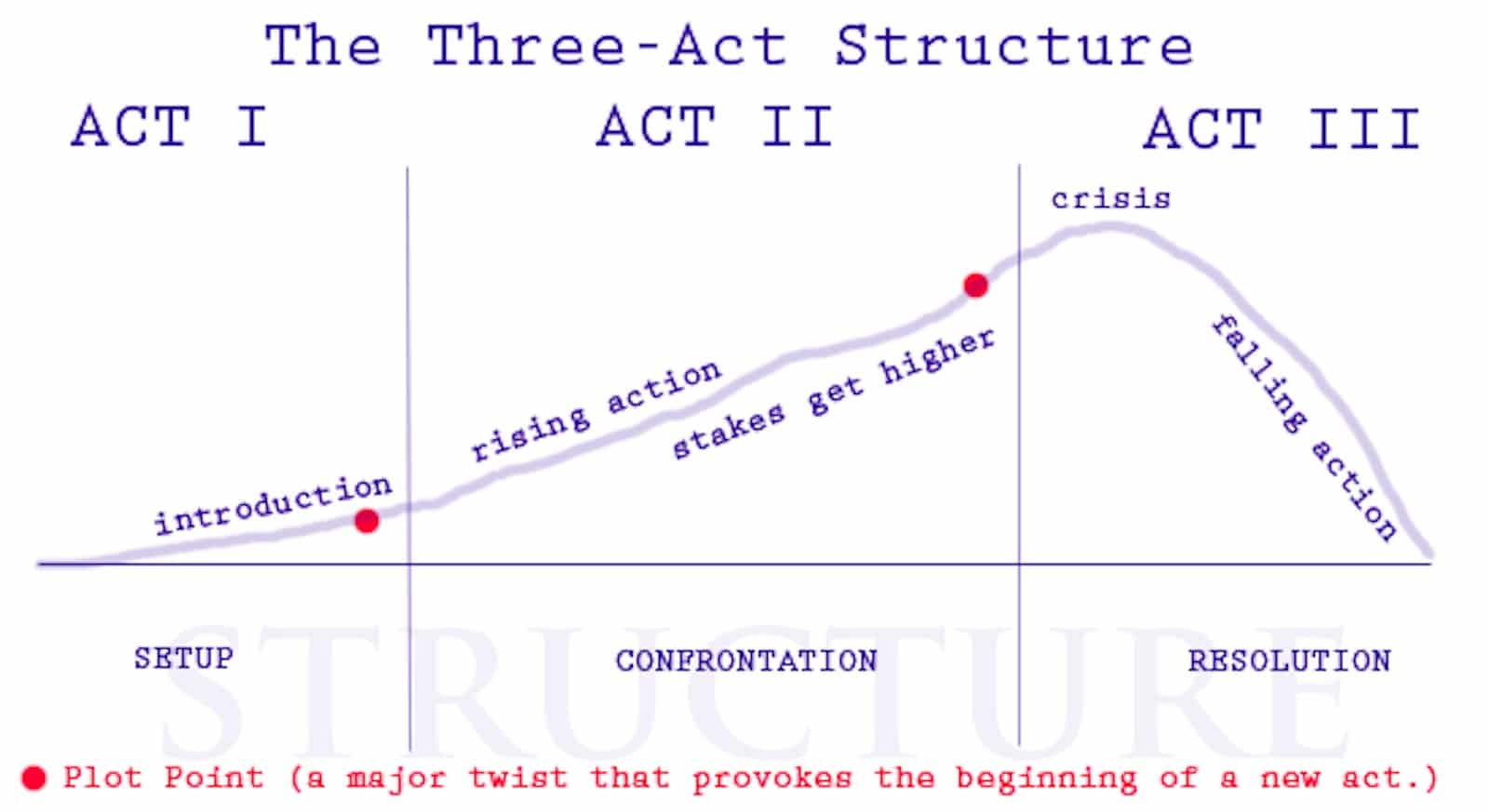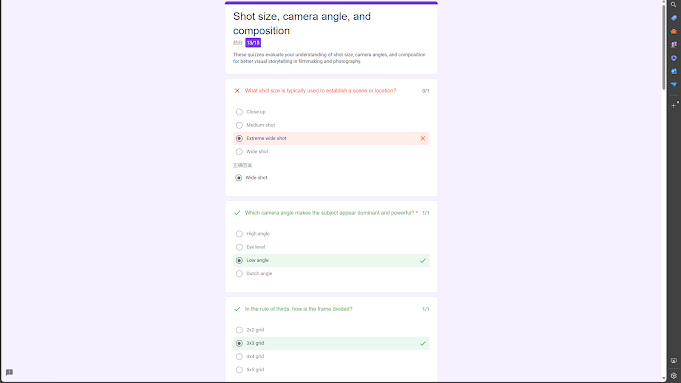Video & Sound Production Exercises
2024/4/22 - 2024/7/26
 |
| The Three-Act Structure |
- Purpose: Introduce the main characters, setting, and the central conflict.
- Content: This act starts with an opening scene that grabs the audience's attention and sets the tone for the movie. It includes the inciting incident, which disrupts the life of the protagonist and sets them on their journey. This act establishes the stakes and lays out the protagonist’s goal. Background information is provided to help the audience understand the world and the characters.
- Purpose: Explore the conflict in depth, presenting obstacles and complications.
- Content: This is often the longest act, where the plot deepens and the emotional stakes are raised. The protagonist faces a series of challenges that test their resolve, skills, and character. This act often includes a midpoint, a crucial event or revelation that changes the protagonist’s approach or intensifies their commitment to the goal. The act continues with rising action and complications, leading to the act's climax, which sets up the final act.
- Purpose: Resolve the story’s conflicts and character arcs.
- Content: This act delivers the climax of the story, where the main tensions reach their peak. It's followed by the falling action and the resolution where the protagonist either achieves their goal or fails. The resolution ties up loose ends and often provides a reflection on the journey or a glimpse into how the characters have changed. This act concludes with a final scene that leaves a lasting impression on the audience, providing closure to the narrative.
- Opening Image: Sets the tone, mood, and style of the story.
- Theme Stated: The story's theme is subtly introduced, often in dialogue.
- Set-Up: Introduction of the main characters and their world.
- Catalyst: The inciting incident that shakes up the protagonist’s life.
- Debate: A moment of hesitation or questioning of the new challenge.
- Break into Two: The protagonist decides to take action and enters a new world or situation.
- B Story: A subplot that usually involves a love interest or a secondary theme, supporting the main narrative.
- Fun and Games: The heart of the movie where the promise of the premise is delivered.
- Midpoint: A significant event that raises the stakes, often turning the story in a new direction.
- Bad Guys Close In: Complications and higher stakes; the protagonist's problems worsen.
- All Is Lost: The lowest point for the protagonist; a moment of great despair.
- Dark Night of the Soul: The protagonist grapples with how far they are from their goal.
- Break into Three: Inspired by new information or resolution, the protagonist decides to confront the central conflict.
- Finale: The climax where the protagonist faces the main conflict and their growth is tested.
- Final Image:A mirror to the opening image, showing how the protagonist and their world have changed.
Which part is act 1, act 2, act 3 respectively? Describe each act with ONE paragraph only.
In "Everything Everywhere All at Once," the three acts are distinctively marked by shifts in tone, scope, and stakes:
- Act 1: The film begins by establishing Evelyn Wang's mundane life as she struggles with the demands of her failing laundromat, strained relationships, and an impending IRS audit led by Deirdre Beaubeirdre. During a tax meeting, Evelyn's life takes a surreal turn when her husband, Waymond, reveals himself as an emissary from another universe. He informs her about the multiverse and her pivotal role in stopping a powerful villain who threatens to destroy it. This act sets up the personal and cosmic challenges Evelyn faces, highlighting her initial disbelief and confusion.
- Act 2: Act 2 plunges Evelyn deeper into the multiverse chaos, where she experiences lives where she made different choices, leading to vastly different outcomes. She learns to harness skills and memories from her other selves to navigate the challenges and battles across dimensions. This act focuses heavily on her growth and the expansion of her understanding of the multiverse, all while she battles both physical and emotional foes, including her daughter Joy's alternate universe counterpart, Jobu Tupaki, who plays a central role in the multiverse's instability.
- Act 3: The final act climaxes with Evelyn's confrontation with Jobu Tupaki and a deeper exploration of her relationship with her daughter, Joy. As the existential and literal battles intensify, Evelyn grapples with the themes of acceptance and love in the face of chaos. The resolution comes with Evelyn applying the lessons she's learned from her experiences in the multiverse to reconcile with her family and embrace the complexity of her life, culminating in a poignant, surreal, and emotional finale that blends the absurd with the deeply personal.
What is the inciting incident in the movie?
The inciting incident in "Everything Everywhere All at Once" occurs when Evelyn Wang is at the IRS office for her audit, and her husband, Waymond, suddenly changes his behavior. He turns from his usual meek self into a confident and urgent messenger from another universe. Waymond reveals to Evelyn that she must connect with different versions of herself across the multiverse to prevent a catastrophic event. This revelation propels Evelyn into the film's central narrative of multiverse adventure and is the moment that disrupts her ordinary world, setting the entire plot in motion.
What is the midpoint scene in the movie?
The midpoint of "Everything Everywhere All at Once" occurs when Evelyn fully embraces the multiverse's possibilities and begins to actively use the skills and memories of her alternate selves. This pivotal scene is marked by her fight in the IRS office, where she demonstrates a newfound mastery of bizarre, physics-defying combat techniques. During this sequence, she hops between various universes, using skills ranging from martial arts to peculiar abilities like wielding sausages as nunchucks. This shift is crucial as it represents Evelyn's transition from confusion and denial about the multiverse to taking control and actively engaging with her alternate lives to address the challenges she faces. This moment significantly raises the stakes and deepens her commitment to resolving the multiversal crisis, propelling the narrative into its more intense second half.
What is the Climax scene in the movie?
The climax of "Everything Everywhere All at Once" is a deeply emotional and visually dynamic confrontation between Evelyn and her daughter Joy's alternate universe counterpart, Jobu Tupaki. This showdown takes place in the multiverse's void, where the stakes of their conflict reach their peak. Jobu Tupaki, overwhelmed by the chaotic possibilities of the multiverse and her own existential despair, threatens to destroy all realities with a "bagel of everything" that symbolizes nihilism and the convergence of all possibilities into nothingness.
In this climax, Evelyn must not only physically confront her daughter but also emotionally connect with her, addressing the pain and misunderstanding that have built up in their relationship. Evelyn's realization that love and acceptance are the keys to saving her daughter and the multiverse leads to a heartfelt reconciliation. She convinces Jobu Tupaki to abandon her destructive plan, highlighting the film’s themes of connection, understanding, and the complexity of human relationships amidst the absurdity of their situation. This resolution of both external and internal conflicts marks the climax of the film, setting up the subsequent denouement where the characters embrace their multifaceted lives.
What is the theme of the movie?
Midground: This is the area between the foreground and the background. It acts as a transitional zone, where the main subject of the image often resides, providing a sense of depth.
Background: This is the part of the scene that lies behind the main subject of the image. It often provides contextual information and helps to add depth and layers to the composition.
 |
| 免费 AI 艺术创作 - SeaArt AI |
Depth of Field (DoF) refers to the range of distance within a photograph that appears acceptably sharp. It indicates how much of the background and foreground area around the focal point is in focus.
Deep Depth of Field means more of the image is in focus, from the foreground to the background. It's often used in landscapes to ensure everything from the nearest to the farthest points are sharp.
 |
| 免费 AI 艺术创作 - SeaArt AI |
Shallow Depth of Field means only a small part of the image, typically where the subject is focused, is sharp, while the rest of the image (foreground and background) is blurred. This effect is often used in portraits to emphasize the subject by blurring the background.
 |
| 免费 AI 艺术创作 - SeaArt AI |
Deep Depth of Field: This landscape image shows everything from the close-up flowers to the distant mountains in sharp focus, illustrating a deep depth of field.
Shallow Depth of Field: This portrait image highlights a woman reading a book in a park, with her sharply in focus and the background featuring blurred trees and people, depicting a shallow depth of field.
The 180 degree rule is a basic guideline in film making and cinematography that helps maintain spatial consistency and orientation in a scene. This rule stipulates that two characters in a scene should maintain the same left/right relationship to each other. To achieve this, the camera should stay on one side of an imaginary line drawn between the two characters. This line is often referred to as the "axis of action."
By keeping the camera on one side of this axis, the spatial relationship between the characters remains consistent to the viewer, avoiding potential confusion. Crossing this line can disorient the audience because the characters will appear flipped.
Continuity in cinematography refers to the seamless flow of the action or the visual narrative from one shot to another without any jarring visual contradictions. It ensures that the story moves forward in a way that is logically coherent and visually stable, helping the audience maintain their suspension of disbelief. Continuity involves maintaining consistent character positions, props, costume, and the direction of movement from shot to shot.
To determine if a video adheres to the 180 degree rule, you would watch to see if the camera maintains its position relative to the axis of action throughout the scene. If the camera crosses this line, it can result in a reverse in the screen direction (i.e., a character that was on the left in one shot appears on the right in the next), which can be disorienting unless done deliberately for a specific effect.
If you have a specific video or scene in question, I can help analyze it based on a description or by viewing stills to determine if it adheres to the 180 degree rule.
 |
| Week 2 asynchronous class Quiz result |
feedback:My PR version is different from Mr. Martin’s demonstration. The operation interface is different. I need additional software learning to better keep up with the rhythm.
 |
| Week 3 asynchronous class Quiz result |
feedback:I found that this course requires bold creativity. The current assignments are not that difficult, but it is foreseeable that I have to feel bold enough to try various ideas. Just sitting in front of a computer will not lead to success








%202024_5_18%2014_47_28.png)







评论
发表评论